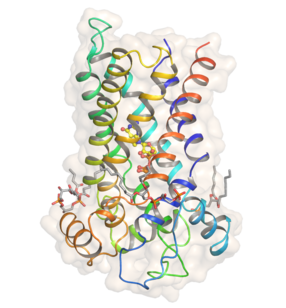
An uncoupling protein (UCP) is a mitochondrial inner membrane protein that is a regulated proton channel or transporter. An uncoupling protein is thus capable of dissipating the proton gradient generated by NADH-powered pumping of protons from the mitochondrial matrix to the mitochondrial intermembrane space. The energy lost in dissipating the proton gradient via UCPs is not used to do biochemical work. Instead, heat is generated. This is what links UCP to thermogenesis. However, not every type of UCPs are related to thermogenesis. Although UCP2 and UCP3 are closely related to UCP1, UCP2 and UCP3 do not affect thermoregulatory abilities of vertebrates.[1] UCPs are positioned in the same membrane as the ATP synthase, which is also a proton channel. The two proteins thus work in parallel with one generating heat and the other generating ATP from ADP and inorganic phosphate, the last step in oxidative phosphorylation.[2] Mitochondria respiration is coupled to ATP synthesis (ADP phosphorylation), but is regulated by UCPs.[3][4] UCPs belong to the mitochondrial carrier (SLC25) family.[5][6]
Uncoupling proteins play a role in normal physiology, as in cold exposure or hibernation, because the energy is used to generate heat (see thermogenesis) instead of producing ATP. Some plants species use the heat generated by uncoupling proteins for special purposes. Eastern skunk cabbage, for example, keeps the temperature of its spikes as much as 20 °C higher than the environment, spreading odor and attracting insects that fertilize the flowers.[7] However, other substances, such as 2,4-dinitrophenol and carbonyl cyanide m-chlorophenyl hydrazone, also serve the same uncoupling function. Salicylic acid is also an uncoupling agent (chiefly in plants) and will decrease production of ATP and increase body temperature if taken in extreme excess.[8] Uncoupling proteins are increased by thyroid hormone, norepinephrine, epinephrine, and leptin.[9]
- ^ Gaudry MJ, Jastroch M (March 2019). "Molecular evolution of uncoupling proteins and implications for brain function". Neuroscience Letters. 696: 140–145. doi:10.1016/j.neulet.2018.12.027. PMID 30582970. S2CID 56595077.
- ^ Nedergaard J, Ricquier D, Kozak LP (October 2005). "Uncoupling proteins: current status and therapeutic prospects". EMBO Reports. 6 (10): 917–21. doi:10.1038/sj.embor.7400532. PMC 1369193. PMID 16179945.
- ^ Cite error: The named reference
Rousset_2004was invoked but never defined (see the help page). - ^ Nicholls, D.G. (2021). "Mitochondrial proton leaks and uncoupling proteins". Biochim Biophys Acta Bioenerg. 1862 (7): 148428. doi:10.1016/j.bbabio.2021.148428. PMID 33798544. S2CID 232774851.
- ^ Ruprecht, J.J.; Kunji, E.R.S. (2020). "The SLC25 Mitochondrial Carrier Family: Structure and Mechanism". Trends Biochem. Sci. 45 (3): 244–258. doi:10.1016/j.tibs.2019.11.001. PMC 7611774. PMID 31787485.
- ^ Kunji, E.R.S.; King, M.S.; Ruprecht, J.J.; Thangaratnarajah, C. (2020). "The SLC25 Carrier Family: Important Transport Proteins in Mitochondrial Physiology and Pathology". Physiology (Bethesda). 35 (5): 302–327. doi:10.1152/physiol.00009.2020. PMC 7611780. PMID 32783608.
- ^ Garrett RH, Grisham CM (2013). Biochemistry (Fifth Edition, International ed.). China: Mary Finch. p. 668. ISBN 978-1-133-10879-5.
- ^ "California Poison Control System: Salicylates". Archived from the original on 2014-08-02.
- ^ Gong DW, He Y, Karas M, Reitman M (September 1997). "Uncoupling protein-3 is a mediator of thermogenesis regulated by thyroid hormone, beta3-adrenergic agonists, and leptin". The Journal of Biological Chemistry. 272 (39): 24129–32. doi:10.1074/jbc.272.39.24129. PMID 9305858.